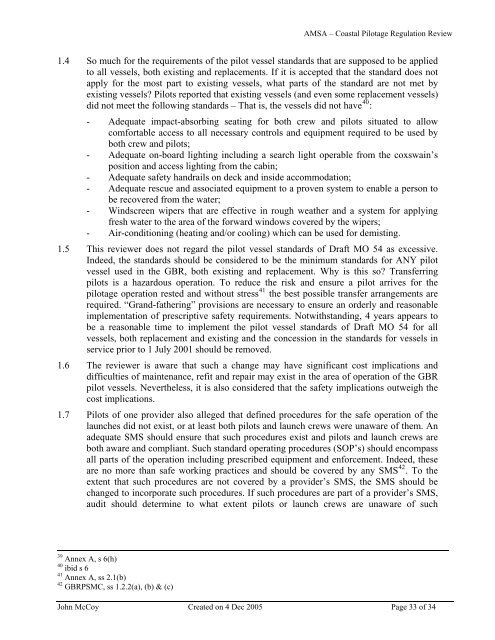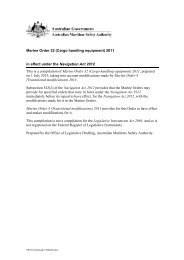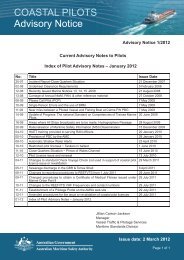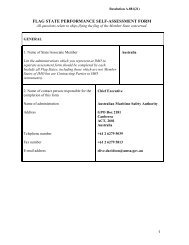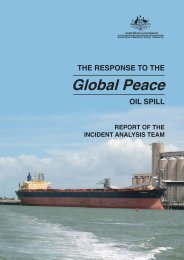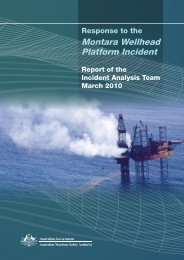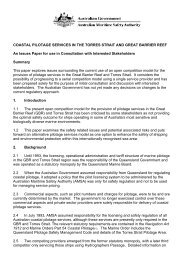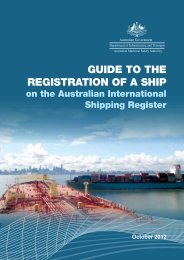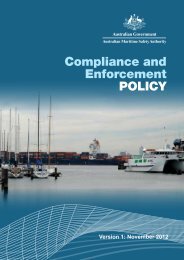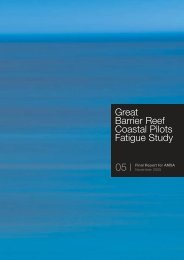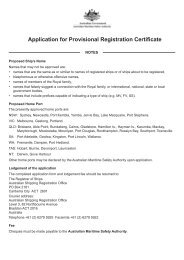Coastal pilotage regulation review - Australian Maritime Safety ...
Coastal pilotage regulation review - Australian Maritime Safety ...
Coastal pilotage regulation review - Australian Maritime Safety ...
You also want an ePaper? Increase the reach of your titles
YUMPU automatically turns print PDFs into web optimized ePapers that Google loves.
AMSA – <strong>Coastal</strong> Pilotage Regulation Review1.4 So much for the requirements of the pilot vessel standards that are supposed to be appliedto all vessels, both existing and replacements. If it is accepted that the standard does notapply for the most part to existing vessels, what parts of the standard are not met byexisting vessels? Pilots reported that existing vessels (and even some replacement vessels)did not meet the following standards – That is, the vessels did not have 40 :- Adequate impact-absorbing seating for both crew and pilots situated to allowcomfortable access to all necessary controls and equipment required to be used byboth crew and pilots;- Adequate on-board lighting including a search light operable from the coxswain’sposition and access lighting from the cabin;- Adequate safety handrails on deck and inside accommodation;- Adequate rescue and associated equipment to a proven system to enable a person tobe recovered from the water;- Windscreen wipers that are effective in rough weather and a system for applyingfresh water to the area of the forward windows covered by the wipers;- Air-conditioning (heating and/or cooling) which can be used for demisting.1.5 This <strong>review</strong>er does not regard the pilot vessel standards of Draft MO 54 as excessive.Indeed, the standards should be considered to be the minimum standards for ANY pilotvessel used in the GBR, both existing and replacement. Why is this so? Transferringpilots is a hazardous operation. To reduce the risk and ensure a pilot arrives for the<strong>pilotage</strong> operation rested and without stress 41 the best possible transfer arrangements arerequired. “Grand-fathering” provisions are necessary to ensure an orderly and reasonableimplementation of prescriptive safety requirements. Notwithstanding, 4 years appears tobe a reasonable time to implement the pilot vessel standards of Draft MO 54 for allvessels, both replacement and existing and the concession in the standards for vessels inservice prior to 1 July 2001 should be removed.1.6 The <strong>review</strong>er is aware that such a change may have significant cost implications anddifficulties of maintenance, refit and repair may exist in the area of operation of the GBRpilot vessels. Nevertheless, it is also considered that the safety implications outweigh thecost implications.1.7 Pilots of one provider also alleged that defined procedures for the safe operation of thelaunches did not exist, or at least both pilots and launch crews were unaware of them. Anadequate SMS should ensure that such procedures exist and pilots and launch crews areboth aware and compliant. Such standard operating procedures (SOP’s) should encompassall parts of the operation including prescribed equipment and enforcement. Indeed, theseare no more than safe working practices and should be covered by any SMS 42 . To theextent that such procedures are not covered by a provider’s SMS, the SMS should bechanged to incorporate such procedures. If such procedures are part of a provider’s SMS,audit should determine to what extent pilots or launch crews are unaware of such39 Annex A, s 6(h)40 ibid s 641 Annex A, ss 2.1(b)42 GBRPSMC, ss 1.2.2(a), (b) & (c)John McCoy Created on 4 Dec 2005 Page 33 of 34


